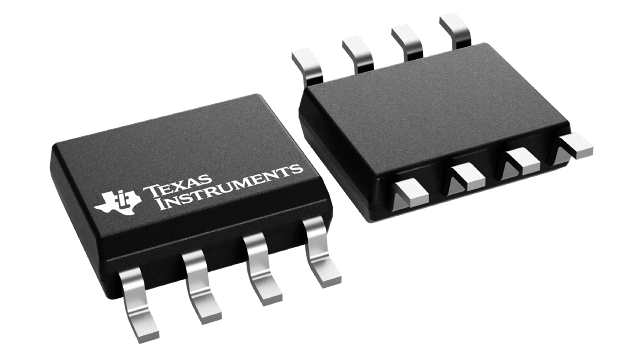Packaging information
| Package | Pins SOIC (D) | 8 |
| Operating temperature range (°C) -40 to 85 |
| Package qty | Carrier 2,500 | LARGE T&R |
Features for the OPA846
- HIGH BANDWIDTH: 400MHz (G = +10)
- LOW INPUT VOLTAGE NOISE: 1.2nV/√Hz
- VERY LOW DISTORTION: –100dBc (5MHz)
- HIGH SLEW RATE: 625V/µs
- HIGH DC ACCURACY: VIO ±150µV
- LOW SUPPLY CURRENT: 12.6mA
- HIGH GAIN BANDWIDTH PRODUCT: 1750MHz
- STABLE FOR GAINS ≥ 7
- APPLICATIONS
- HIGH DYNAMIC RANGE ADC PREAMPS
- LOW–NOISE, WIDEBAND, TRANSIMPEDANCE AMPLIFIERS
- WIDEBAND, HIGH GAIN AMPLIFIERS
- LOW–NOISE DIFFERENTIAL RECEIVERS
- VDSL LINE RECEIVERS
- ULTRASOUND CHANNEL AMPLIFIERS
- SECURITY SENSOR FRONT ENDS
- UPGRADE FOR THE OPA686, CLC425, AND LMH6624
All trademarks are the property of their respective owners.
Description for the OPA846
The OPA846 combines very high gain bandwidth and large signal performance with very low input voltage noise, while dissipating a low 12.6mA supply current. The classical differential input stage, along with two stages of forward gain and a high power output stage, combine to make the OPA846 an exceptionally low distortion amplifier with excellent DC accuracy and output drive. The voltage-feedback architecture allows all standard op amp applications to be implemented with very high performance.
The combination of low input voltage and current noise, along with a 1.75GHz gain bandwidth product, make the OPA846 an ideal amplifier for wideband transimpedance stages. As a voltage gain stage, the OPA846 is optimized for a flat response at a gain of +10 and is stable down to a gain of +7.
A new external compensation technique can be used to give a very flat frequency response below the minimum stable gain for the OPA846, further improving its already exceptional distortion performance. Using this compensation makes the OPA846 one of the premier 12– to 16–bit Analog–to–Digital (A/D) converter input drivers. The supply current for the OPA846 is precisely trimmed to 12.6mA at +25°C. This, along with carefully defined supply current tempco in the input and output stages, combine to provide exceptional performance over the full specified temperature range.
